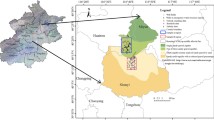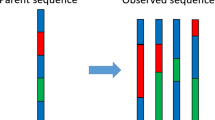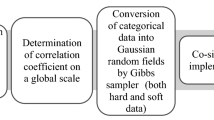Abstract
This paper is an extension of the two-dimensional coupled Markov chain model developed by Elfeki and Dekking (2001) supplemented with extensive simulations. We focus on the development of various coupled Markov chains models: the so-called fully forward Markov chain, fully backward Markov chain and forward–backward Markov chain models. We addressed many issues such as: sensitivity analysis of optimal sampling intervals in horizontal and lateral directions, directional dependency, use of Walther’s law to describe lateral variability, effect of conditioning on number of boreholes on the model performance, stability of the Monte Carlo realizations, various implementation strategies, use of cross validation techniques to evaluate model performance and image division for statistically non-homogeneous deposits are addressed. The applications are made on three sites; two sites are located in the Netherlands, and the third is in the USA. The purpose of these applications is to show under which conditions the Markov models can be used, and to provide some guidelines for the practice. Entropy maps are good tools to indicate places where high uncertainty is present, so can be used for designing sampling networks to reduce uncertainty at these locations. Symmetric and diagonally dominant horizontal transition probabilities with proper sampling interval show plausible results (fits with geologists prediction) in terms of delineation of subsurface heterogeneous structures. Walther’s law can be utilised with a proper sampling interval to account for the lateral variability.
Similar content being viewed by others
References
M. F. P. Bierkens (1994) Complex confining layers: a stochastic analysis of hydraulic properties at various scales Utrecht university Utrecht, The Netherlands 263
C. Arndt (2001) Information measures Information and its description in science and engineering Springer-Verlag Berlin
P. Billingsley (1995) Probability and measure EditionNumber3 Wiley-Interscience publication, John Wiley and Sons New york
S. F. Carle G. E. Fogg (1996) ArticleTitleTransition probability-based indicator geostatistics Mathematical Geology 28 IssueID4 453–476 Occurrence Handle10.1007/BF02083656
Carle, S. F., LaBolle, E. M., Weissmann, G. S. VanBrocklin D. and Fogg, G. E. (1998) Conditional simulation of hydrofacies architecture: A transition probability/Markov approach, In G. S. Fraser and J. M. Davis (eds.), Hydrogeologic Models of Sedimentary Aquifers, SEPM Concepts in Hydrol. Environ. Geol., Soc. For Sediment. Geol.,Tulsa, OK, Vol. 1, pp. 147–170.
A. Chessa (1995) Conditional simulation of spatial stochastic models for reservoir heterogeneity Delft University of Technology The Netherlands
J. C. Davis (1986) Statistics and Data Analysis in Geology John Wiley and Sons New York 646
C. V. Deutsch A. G. Journel (1992) GSLIB; Geostatistics Software Library and user’s guide Oxford Univ Press New York 340
Doveton, J. H. (1994) Theory and application of vertical variability measures from Markov chain analysis, In J.M. Yarus, and R.L. Chambers (eds.), Stochastic Modelling And Geostatistics- Principles, Methods and Case Studies: American Association Of Petroleum Geologists, Computer Methods In Geology, Vol. 3, pp 55–64.
J. R. Eggleston S. A. Rojstaczer J. J. Peirce (1996) ArticleTitleIdentification of hydraulic conductivity structure in sand and gravel aquifers: Cape cod data set Water Resources Research 32 IssueID5 1209–1222 Occurrence Handle10.1029/96WR00272
Elfeki, A. M. M. and Dekking, F. M. (2001) A Markov chain model for subsurface characterization: theory and applications, Mathematical Geology 3.
Elfeki, A. M. M. and Rajabiani, H. R. (2002) Simulation of plume behavior at the macrodispersion experiment (Made1) site by applying the coupled Markov chain model for site characterization. In: 14th International Conference on Computational Methods in Water Resources “CMWR2002” Delft, The Netherlands Elsevier Publisher, pp. 655–662.
H. H. Haldorsen E. Damsleth (1990) ArticleTitleStochastic modelling Journal of Petroleum Technology 42 IssueID4 404–412
W. C. Krumbein (1967) Fortran Computer Program for Markov Chain Experiments in Geology: Computer Contribution 13 Kansas geological survey Lawrence Kansas
G. V. Middleton (1973) ArticleTitleJohannes Walther’s law of the correlation of facies Geological Society of America, Bulletin 84 979–988
Navoy, A. S. (1991) Aquifer-estuary Interaction and Vulnerability of Groundwater Supplies to sea level rise-driven saltwater intrusion, PhD Thesis, Pennsylvania State University, 225 pp.
Owens, J. P. and Sohl, N. F. (1969) Shelf and deltaic paleo-environments in the Cretaceous-Tertiary formation of the New Jersey coastal plain In: Subitzky and Seymour (ed.), Geology of the Selected Areas In New Jersey and Eastern Pennsylvania and Guidebook of Excursions: Geological Society of America And Associated Societies, November 1969, Annual Meeting, Atlantic city, N.J., New Brunswick, N. J., Rutgers University Press, pp. 235–278.
K.P. Parks L.R. Bentley A.S. Crowe (2000) ArticleTitleCapturing geological realism in stochastic simulations of rock systems with Markov statistics and simulated annealing Journal of Sedimentary Research 70 IssueID4 803–813
Rajabiani, H. (2001) Characterization of subsurface heterogeneity from boreholes with coupled Markov chain for groundwater transport, MSc Thesis, Section Hydrology and Ecology, TU Delft, Delft, The Netherlands, 76 p.
Wheatcraft, S. W. and Cushman, J. H. (1991) Hierarchical approaches to transport in heterogeneous porous media, Reviews of Geophysics supplement, 263–269.
Author information
Authors and Affiliations
Corresponding author
Rights and permissions
About this article
Cite this article
Elfeki, A.M.M., Dekking, F.M. Modelling Subsurface Heterogeneity by Coupled Markov Chains: Directional Dependency, Walther’s Law and Entropy. Geotech Geol Eng 23, 721–756 (2005). https://doi.org/10.1007/s10706-004-2899-z
Issue Date:
DOI: https://doi.org/10.1007/s10706-004-2899-z




